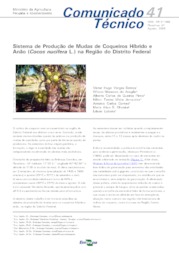Sistema de produção de mudas de coqueiros híbrido e anão (Cocos nucifera L.) na região do Distrito Federal.
Sistema de produção de mudas de coqueiros híbrido e anão (Cocos nucifera L.) na região do Distrito Federal.
Autoria: VARGAS RAMOS, V. H.; ARAGAO, W. M. de; PINTO, A. C. de Q.; JUNQUEIRA, N. T. V.; GOMES, A. C.; OLIVEIRA, M. A. S.; LOBATO, E.
Resumo: ABSTRACT: The coconut cultivated area has greatly increased in the Federal District Region of Brazil for the last five years. However, the crop management is still poor on seedling production. Therefore, the improvement of production methods has been highly demanded by coconut growers. Coconut seeds (fruits) should be collected from a superior genetic material and the seedlings should be vigorous, of pest and disease free and well established. The first step is the appropriate age to harvest the fruits, 11 to 12 months after opening the spathe. There is no difference in germination rate for no cutting or cutting on basal position of the fruits before sowing them. Cutting is less adopted by growers, and no cutting seems to be more practical and less time-consuming. Types of sowing systems: the traditional method, where fruits are left to geminate in seedbed, carried out to nurseries and then to the field. In the alternative method, the fruits are kept in the vertical position with a density of 15 to 20 nuts/m2. Four months later the seedlings are taken directly to the field. This placement of fruits is highly recommended because it avoids breaking of basal part of the stem and takes less time for seedling production, resulting in a better seedling establishment in the field. An adequate orchard management, especially regarding to irrigation and fertilization, is a very important practice to improve productivity, earlyness and fruit quality. The equilateral triangle is the recommended spacing type, since it allows higher penetration of light in the coconut canopy. The objective of this work was determine seedling production method for Federal District Region, and to suggest appropriate practices for establishment of coconut orchard in the field.
Ano de publicação: 2000
Tipo de publicação: Folhetos
Unidade: Embrapa Cerrados
Palavras-chave: Brasil, Cerrado, Coco, Cocos Nucifera, Cuttings, Distrito Federal, Hubrid, Melhoramento Vegetal, Muda, Nursey, Production system, Seedling, Sistema de Produção, Variedade, coconuts, varieties
Conteúdo relacionado
Tecnologias Ver mais
Observações
1 - Por padrão são exibidas publicações dos últimos 20 anos. Para encontrar publicações mais antigas, configure o filtro ano de publicação, colocando o ano a partir do qual você deseja encontrar publicações. O filtro está na coluna da esquerda na busca acima.
2 - Para ler algumas publicações da Embrapa (apenas as que estão em formato ePub), é necessário ter, no celular ou computador, um desses softwares gratuitos. Sistemas Android: Google Play Livros; IOS: iBooks; Windows e Linux: software Calibre.
Acesse outras publicações
Acesse a Base de Dados da Pesquisa Agropecuária (BDPA) para consultar o acervo completo das bibliotecas da Embrapa.

